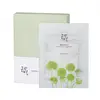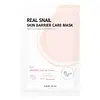What's inside
What's inside
 Key Ingredients
Key Ingredients

 Benefits
Benefits

 Concerns
Concerns

 Ingredients Side-by-side
Ingredients Side-by-side

Water
Skin ConditioningCentella Asiatica Extract
CleansingGlycereth-26
HumectantButylene Glycol
HumectantNiacinamide
Smoothing1,2-Hexanediol
Skin ConditioningHydroxyacetophenone
AntioxidantArginine
MaskingAcrylates/C10-30 Alkyl Acrylate Crosspolymer
Emulsion StabilisingHydroxyethylcellulose
Emulsion StabilisingCarrageenan
Polyglyceryl-4 Caprate
EmulsifyingPolyglyceryl-6 Caprylate
EmulsifyingAdenosine
Skin ConditioningEthylhexylglycerin
Skin ConditioningDisodium EDTA
Helianthus Annuus Seed Oil
EmollientPanthenol
Skin ConditioningArtemisia Princeps Leaf Extract
Skin ConditioningLycium Chinense Fruit Extract
AntioxidantPropanediol
SolventPortulaca Oleracea Extract
Skin ConditioningPanax Ginseng Root Extract
EmollientCamellia Sinensis Leaf Extract
AntimicrobialAnthemis Nobilis Flower Oil
MaskingSodium Hyaluronate
HumectantHydrolyzed Hyaluronic Acid
HumectantHyaluronic Acid
HumectantWater, Centella Asiatica Extract, Glycereth-26, Butylene Glycol, Niacinamide, 1,2-Hexanediol, Hydroxyacetophenone, Arginine, Acrylates/C10-30 Alkyl Acrylate Crosspolymer, Hydroxyethylcellulose, Carrageenan, Polyglyceryl-4 Caprate, Polyglyceryl-6 Caprylate, Adenosine, Ethylhexylglycerin, Disodium EDTA, Helianthus Annuus Seed Oil, Panthenol, Artemisia Princeps Leaf Extract, Lycium Chinense Fruit Extract, Propanediol, Portulaca Oleracea Extract, Panax Ginseng Root Extract, Camellia Sinensis Leaf Extract, Anthemis Nobilis Flower Oil, Sodium Hyaluronate, Hydrolyzed Hyaluronic Acid, Hyaluronic Acid
Water
Skin ConditioningGlycerin
HumectantPropanediol
SolventBetaine
HumectantDipropylene Glycol
HumectantHydroxyacetophenone
AntioxidantPanthenol
Skin ConditioningAmmonium Polyacryloyldimethyl Taurate
Emulsion StabilisingCaprylyl Glycol
EmollientPolyglyceryl-10 Laurate
Skin ConditioningT-Butyl Alcohol
Perfuming1,2-Hexanediol
Skin ConditioningButylene Glycol
HumectantLavandula Hybrida Oil
EmollientSodium Hyaluronate
HumectantHydrolyzed Corn Starch
HumectantDipotassium Glycyrrhizate
HumectantSucrose
HumectantSnail Secretion Filtrate
Skin ConditioningDisodium EDTA
Linalool
PerfumingWater, Glycerin, Propanediol, Betaine, Dipropylene Glycol, Hydroxyacetophenone, Panthenol, Ammonium Polyacryloyldimethyl Taurate, Caprylyl Glycol, Polyglyceryl-10 Laurate, T-Butyl Alcohol, 1,2-Hexanediol, Butylene Glycol, Lavandula Hybrida Oil, Sodium Hyaluronate, Hydrolyzed Corn Starch, Dipotassium Glycyrrhizate, Sucrose, Snail Secretion Filtrate, Disodium EDTA, Linalool
 Reviews
Reviews

Ingredients Explained
These ingredients are found in both products.
Ingredients higher up in an ingredient list are typically present in a larger amount.
1,2-Hexanediol is a synthetic liquid and another multi-functional powerhouse.
It is a:
- Humectant, drawing moisture into the skin
- Emollient, helping to soften skin
- Solvent, dispersing and stabilizing formulas
- Preservative booster, enhancing the antimicrobial activity of other preservatives
Butylene Glycol (or BG) is used within cosmetic products for a few different reasons:
Overall, Butylene Glycol is a safe and well-rounded ingredient that works well with other ingredients.
Though this ingredient works well with most skin types, some people with sensitive skin may experience a reaction such as allergic rashes, closed comedones, or itchiness.
Learn more about Butylene GlycolDisodium EDTA plays a role in making products more stable by aiding other preservatives.
It is a chelating agent, meaning it neutralizes metal ions that may be found in a product.
Disodium EDTA is a salt of edetic acid and is found to be safe in cosmetic ingredients.
Learn more about Disodium EDTAHydroxyacetophenone is antioxidant with skin conditioning and soothing properties. It also boosts the efficiency of preservatives.
This ingredient is not irritating or sensitizing.
Panthenol is a common ingredient that helps hydrate and soothe the skin. It is found naturally in our skin and hair.
There are two forms of panthenol: D and L.
D-panthenol is also known as dexpanthenol. Most cosmetics use dexpanthenol or a mixture of D and L-panthenol.
Panthenol is famous due to its ability to go deeper into the skin's layers. Using this ingredient has numerous pros (and no cons):
Like hyaluronic acid, panthenol is a humectant. Humectants are able to bind and hold large amounts of water to keep skin hydrated.
This ingredient works well for wound healing. It works by increasing tissue in the wound and helps close open wounds.
Once oxidized, panthenol converts to pantothenic acid. Panthothenic acid is found in all living cells.
This ingredient is also referred to as pro-vitamin B5.
Learn more about PanthenolPropanediol is an all-star ingredient. It softens, hydrates, and smooths the skin.
It’s often used to:
Propanediol is not likely to cause sensitivity and considered safe to use. It is derived from corn or petroleum with a clear color and no scent.
Learn more about PropanediolSodium Hyaluronate is hyaluronic acid's salt form. It is commonly derived from the sodium salt of hyaluronic acid.
Like hyaluronic acid, it is great at holding water and acts as a humectant. This makes it a great skin hydrating ingredient.
Sodium Hyaluronate is naturally occurring in our bodies and is mostly found in eye fluid and joints.
These are some other common types of Hyaluronic Acid:
Learn more about Sodium HyaluronateWater. It's the most common cosmetic ingredient of all. You'll usually see it at the top of ingredient lists, meaning that it makes up the largest part of the product.
So why is it so popular? Water most often acts as a solvent - this means that it helps dissolve other ingredients into the formulation.
You'll also recognize water as that liquid we all need to stay alive. If you see this, drink a glass of water. Stay hydrated!
Learn more about Water